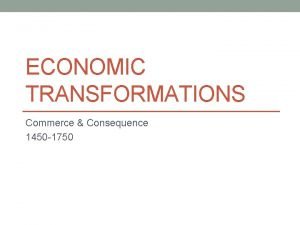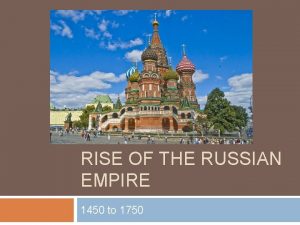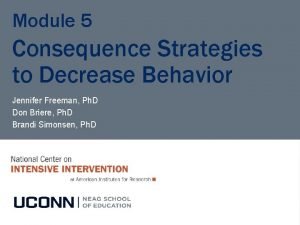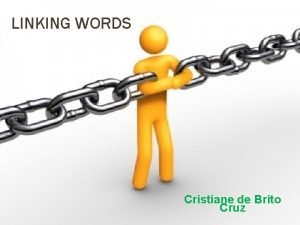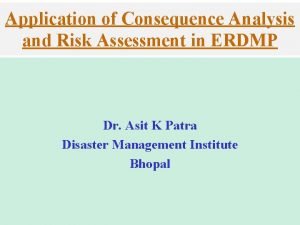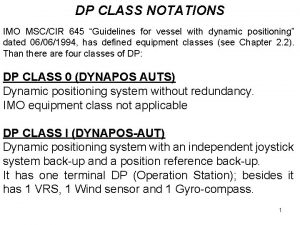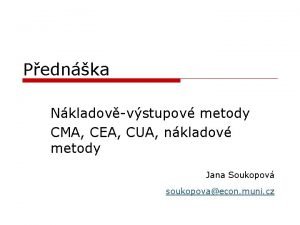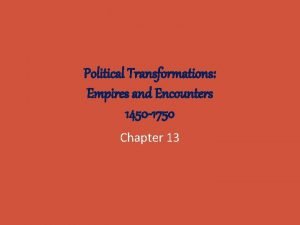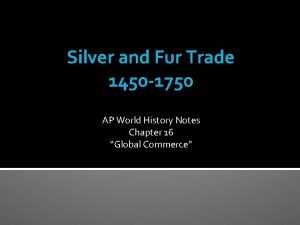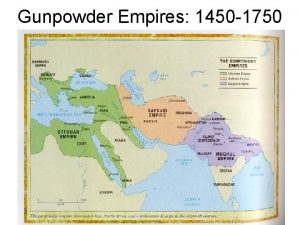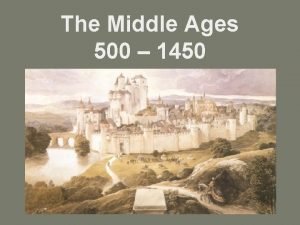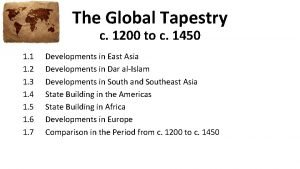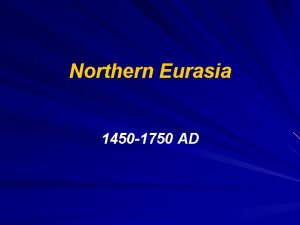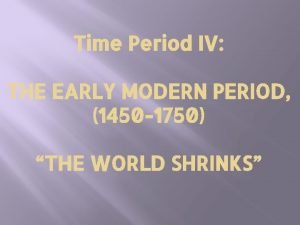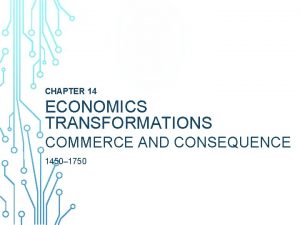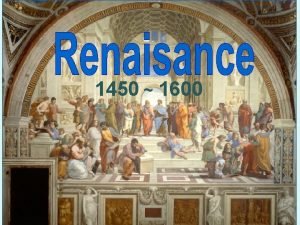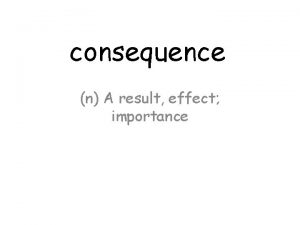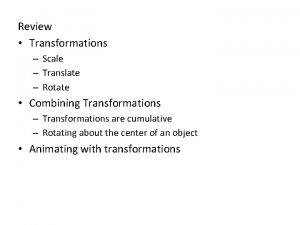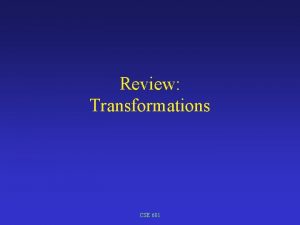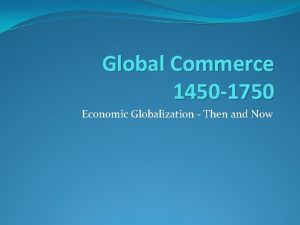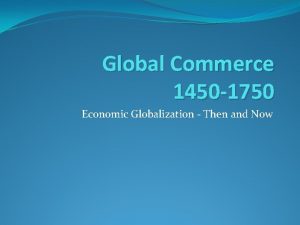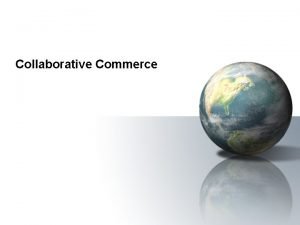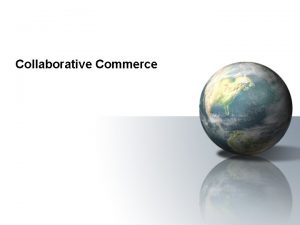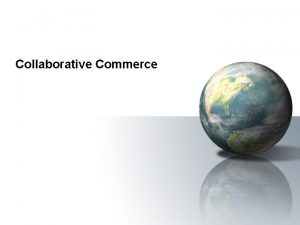Economic Transformations Chapter 14 Commerce and Consequence 1450




































- Slides: 36

Economic Transformations Chapter 14 – Commerce and Consequence, 1450 – 1750

European and Asian Commerce �Europeans wanted commercial connections with Asia: - Columbus and Da Gama looked for spices (pepper). - Europeans wanted silk, cotton, emeralds, rubies; etc. - Europe had recovered from the plague. - Monarchies learned to govern more efficiently. - Resentment of Italian city-states and Muslims for monopoly on goods from Asia through the Middle East. - Constant trade deficit with Asia: need for bullion.

Christopher Columbus

Map of Europeans in Asia

A Portuguese Empire of Commerce �Indian Ocean trade was rich and diverse. �Portugal was first to arrive with Vasco Da Gama. �Portugal didn’t have anything good to trade: - so they used piracy to gain control. - they had smaller, faster ships than India and China. �Established a “trading post empire: ” - took several port cities by force with onboard cannons (Macao not taken by force). - didn’t control territories or population. - goal was to control commerce.

Portuguese Trading Post

Spain and the Philippines �Spain was the first to challenge the Portuguese: - They colonized the Philippines following Ferdinand Magellan’s voyage (1519 -1521). �Spanish rule (1565– 1898): the islands had no central government and the Spanish came in with force and the pageantry of the Catholic Church. They were able to win over many local leaders. The result was a relatively peaceful conquest. The Spanish were extremely successful in spreading the Catholic faith.

Spain and the Philippines (Cont’d) �In the south, merchants had recently introduced Islam to the people of the large island of Mindanao. As this area resented Spanish rule and the spread of Catholicism, Islam served as an ideology of resistance. �The capital, port city of Manila became the focus of Spanish activity. Over 20, 000 Chinese came to live in Manila. At times, tensions arose over their poor treatment by the Spanish. This resulted in revolts and massacres. One instance occurred in 1603 when the Spanish killed some 20, 000 Chinese.

Philippines Catholic Festival

East India Companies �The Dutch and British both set-up private companies to handle colonization: - merchants invested, shared the risks. - royal charters gave them the power to make war and govern conquered peoples. �The Dutch Empire focused on Indonesia. �The British Empire focused on India’s ports. �Both gradually evolved into typical colonial domination.

Dutch East India Company �Controlled both shipping and production of cloves, cinnamon, nutmeg, and mace. �Seized small spice-producing islands and forced people to sell only to the Dutch. �In the Banda Islands, the Dutch killed, enslaved, or let starve some 15, 000 inhabitants. They replaced them with Dutch planters and destroyed the crops of farmers who would not cooperate with their planned monopoly. �When the Dutch took control of Taiwan in 1624, they found a local population insufficient for labor and encouraged migration from China. The Chinese population grew and expelled the Dutch in 1662, making it a Chinese province.

Dutch East India Company

British East India Company �Not as well financed or as commercially sophisticated as the Dutch; it couldn’t break into the Spice Islands. �Major ports in India – Bombay, Calcutta; Madras. �Could not compete with the Mughal Empire on land: - negotiated with local rulers. �The British traded pepper and other spices, but cotton textiles and salt eventually became more important.

British East India Company

Asians and Asian Commerce �Portuguese reached Japan in the mid-1500 s. �Japan, at the time, was divided by constant conflict among feudal lords (daimyo) supported by samurai. �At first, Europeans were welcomed: - 300, 000 converted to Christianity. �When Japan unified under the Tokugawa Shogunate: - increasingly regarded Europeans as a threat to unity. - expulsion of missionaries. - massive persecution of Christians. - the Japanese were barred from traveling abroad. - Europeans were banned, except the Dutch at a single site. �Why do you suppose the Dutch could stay but not Spain?

Samurai

Asians and Asian Commerce (Cont’d) �While the Asian economy was still in the hands of Asian merchants, certain groups stood out for their entrepreneurial activity. Chinese merchants could be found throughout Southeast Asia, a region where indigenous Malay women played a prominent role in the local economy. �Throughout Asia, Christian Armenians were active in the commerce that brought Asian goods west to Europe. In India, a number of merchant firms frequently held the upper hand in dealing with the British.

Silver and Global Commerce �Silver was even more important than the spice trade, giving birth to a genuine global exchange network. �Spanish America produced around 85 percent of the world’s silver. It was shipped to the Philippines. �China’s economy: huge, growing demand for silver. �In the 1570 s, all Chinese taxes were paid in silver. �Foreigners with silver could purchase more Chinese products than before.

Silver and Global Commerce (Cont’d) �“Silver drain” to Asia: - why do you suppose most silver wound up there? �The Spanish silver coin, “piece of eight” was widely used for international exchange. �Potosí, Bolivia - largest city in the Americas because it was at the world’s largest silver mine: - the city’s wealthy European elite lived in luxury. - Native American miners lived in horrid conditions. - the environment suffered: deforestation, soil erosion, and flooding.

Silver and Global Commerce (Cont’d) �Silver greatly enriched the Spanish Crown. �Spain, however, created inflation with no real economic growth due to rigid economics. �Spain lost its dominance when the value of silver fell in the early 17 th century. �The Japanese government profited from silver: - Tokugawa shoguns used silver revenues to defeat rivals and unify the country. - they worked with the merchant class to develop a market-based economy. - heavy investments in agriculture and industries.

Silver and Global Commerce (Cont’d) �In China, silver further commercialized the country’s economy: - people needed to sell something to obtain silver to pay their taxes. - the economy became more regionally specialized. - deforestation was a growing problem; it wasn’t addressed as it was in Japan. �Europeans were essentially middlemen in world trade: - funneled American silver to Asia. - Asian commodities took market share from European products.

Map of the Global Silver Trade

Fur in Global Commerce �Europe was in demand for fur by 1500 (little ice age). �Intense competition for the furs of North America: - became very profitable for Indians in N. America. - they received iron tools, guns, textiles; liquor. - unfortunately Indians fell victim to diseases. �Russian fur trade: - Fur was chief motive for Russian expansion. - Similar toll on native Siberians as it had on Indians. - Russia had no competition like in the Americas. - Siberians were forced to provide fur, no negotiations.

A Beautiful Summer Day in Siberia

Map of North American Fur Trade

The Atlantic Slave Trade �Between 1500 and 1866, about 12. 5 million slaves were brought to the Americas from Africa: - millions more died during the journey (1. 8 million). - vast human tragedy. - diaspora created racially mixed societies in the Americas.

Map of the Atlantic Slave Trade

The Slave Trade in Context �Most human societies have had slaves. �Africans had practiced slavery and sold slaves for centuries: - trans-Saharan slave trade to the Mediterranean world. - East African slave trade to the Middle East and the Indian Ocean. �Slavery differed, depending on where and when: - slaves were often assimilated into their owners’ households. - children of slaves were sometimes free; sometimes slaves. - Islamic world preferred female slaves. - Atlantic slave trade favored males. - some areas in the Islamic world, slaves often had military and political status.

The Slave Trade in Context (Cont’d) �The scale and importance was enormous. �Plantation agriculture denied all rights: - most slaves prior worked in domestic capacity or worked in shops and were viewed as property. �Slave status was inherited: - little possibility of obtaining freedom. �Slavery was wholly identified with Africa and with “blackness. ” �Slave comes from the word Slav: - sugar plantations in Mediterranean. - Ottoman conquest of Constantinople cut off supply.

Plantation Slavery

The Slave Trade in Context (Cont’d) �Africans chosen since Slavs weren’t available. �Indians had died of European diseases. �Europeans were a bad alternative: Christians from marginal lands couldn’t be enslaved, and indentured servants were expensive. �Africans were farmers, and had some immunity to diseases. They were not Christian, and were readily available. �Long debate on how much racism was involved: - Muslims had some racism in regard to sub-Saharan Africans. - the English had developed an anti-Irish racism, which may have transferred to Africans.

The Slave Trade in Practice �Europeans traded freely with African elites for slaves: - from capture to sale on the coast, trade was in African hands. �Destabilization of African societies: - smaller societies were completely disrupted by slave raids from their neighbors. �Who was enslaved? - People from West Africa: criminals, POW’s; debtors. �Africans generally did not sell their own peoples: - there was no sense of being “African. ” � 80 percent of slaves ended up in Brazil and the Caribbean: - over 14% died on the middle passage.

A Slave Ship

Consequences: The Impact of the Slave Trade in Africa �Slowed Africa’s population growth while it expanded in Europe and China: - Sub-Saharan Africa: represented 18% of world’s population in 1600. By 1900, it was down to 6%. - stagnation and political disruption in Africa. �Very few breakthroughs in agriculture or industry: - very little demand for African products, only its’ people.

Consequences: The Impact of the Slave Trade in Africa (Cont’d) �Some kingdoms (Kongo, Oyo) gradually disintegrated. �Some took advantage of the slave trade: warriors; nobles. �Benin – one of the largest states (West Africa): - monarchy. - largely avoided the slave trade - diversified exports. �Kingdom of Dahomey (to the west of Benin): - slave trade disrupted several small, weak states. - involved in slave trade, controlled by the monarchy. - annual slave raids by the army. - government depended on slave trade for revenue.

Map of the Kingdom of Benin
 Economic transformations commerce and consequence
Economic transformations commerce and consequence Location-based commerce (l-commerce)
Location-based commerce (l-commerce) What is economic growth and development
What is economic growth and development Cause and consequence analysis
Cause and consequence analysis Saq answer example
Saq answer example Russian empire military 1450 to 1750
Russian empire military 1450 to 1750 Economic growth vs economic development
Economic growth vs economic development Economic systems lesson 2 our economic choices
Economic systems lesson 2 our economic choices Consequence strategies examples
Consequence strategies examples Linking words continuation
Linking words continuation Explanation linking words
Explanation linking words Activating event belief consequence
Activating event belief consequence Threat vs consequence
Threat vs consequence Consequence strategies
Consequence strategies Consequence analysis example
Consequence analysis example Antecedent behavior consequence model
Antecedent behavior consequence model Dp class 2 requirements
Dp class 2 requirements Aloha risk assessment software
Aloha risk assessment software Where does frightful build her nest
Where does frightful build her nest Predictive solutions safety net
Predictive solutions safety net Cost consequence analysis
Cost consequence analysis Cost consequence analysis
Cost consequence analysis Proposition principale
Proposition principale Chapter 15 cultural transformations religion and science
Chapter 15 cultural transformations religion and science Chapter 5 political transformations empires and encounters
Chapter 5 political transformations empires and encounters Mughal empire 1450 to 1750
Mughal empire 1450 to 1750 1450 ad
1450 ad Canyon media st george
Canyon media st george Silver trade 1450 to 1750
Silver trade 1450 to 1750 Land based empires 1450 to 1750
Land based empires 1450 to 1750 1450*3
1450*3 500/1450
500/1450 C-1450-1
C-1450-1 Japan 1450-1750
Japan 1450-1750 World map 1450
World map 1450 Europe 1450
Europe 1450 1900-1450
1900-1450
